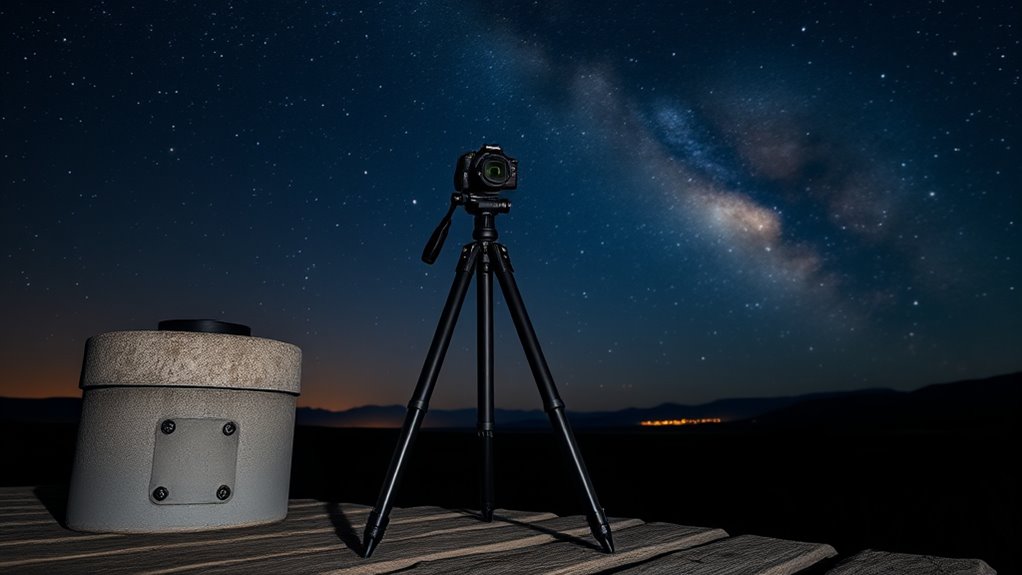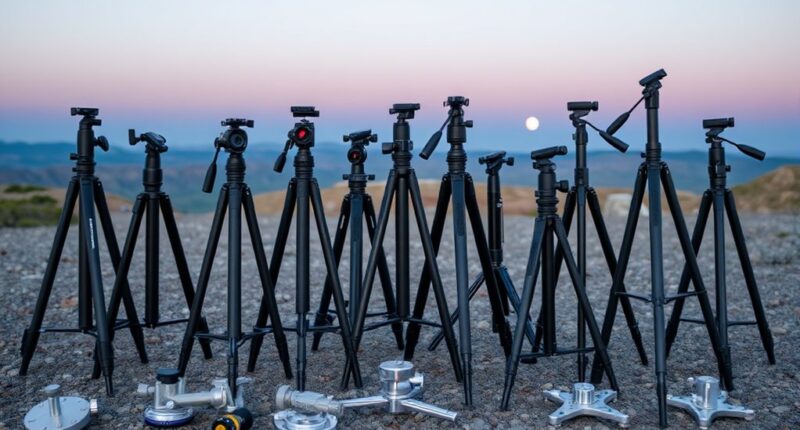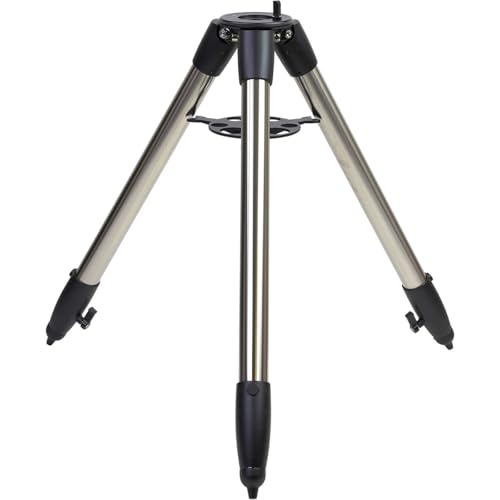If you’re searching for the best tripods and pier mounts for astrophotography in 2025, I recommend considering lightweight, portable options like the Sky-Watcher Star Adventurer GTI and AZ-GTI for total travel convenience. For enhanced stability, models like the iOptron Mini Pier and steel tripods excel for long exposures. Automation and precision are crucial, so mounts like the iEXOS-100-2 and NEQ6 variants shine. If you continue exploring, you’ll discover expert insights into choosing the perfect setup for your astrophotos.
Key Takeaways
- Top picks include lightweight, portable mounts like Sky-Watcher Star Adventurer GTI and iEXOS-100-2 for travel-friendly astrophotography.
- Advanced automation and reliable tracking features are available in mounts such as Sky-Watcher GTI and iOptron Mini Pier.
- Support structures like sturdy tripods and extension piers ensure stability and ease of assembly for precise imaging.
- Compatibility with various cameras and telescopes is a key consideration, with versatile mounting options for different setups.
- Limitations include occasional connectivity issues, limited azimuth adjustment, and payload capacities around 11 lbs, suitable for beginner to intermediate users.
Sky-Watcher Star Adventurer GTI Mount Kit
If you’re looking for a portable, feature-rich mount that makes astrophotography accessible for both beginners and experienced sky enthusiasts, the Sky-Watcher Star Adventurer GTI Mount Kit is an excellent choice. It’s lightweight, versatile, and packed with features like built-in Wi-Fi, an illuminated polar scope, and multiple tracking modes. The full GoTo mount head supports payloads up to 11 pounds, fitting DSLR, mirrorless cameras, and small astrographs. Its compact design, around 26 pounds, and included accessories, like tripod and pier extension, make it ideal for travel. Users praise its ease of setup, reliable tracking, and compatibility with various imaging equipment, making it an excellent investment for astrophotographers on the go.
Best For: amateur and experienced astrophotographers seeking a portable, feature-rich mount for versatile imaging and star tracking.
Pros:
- Lightweight and portable design ideal for travel and field use
- Built-in Wi-Fi and full GoTo capabilities for easy automation and alignment
- Supports a wide range of cameras and small telescopes with reliable tracking
Cons:
- Battery compartment design may require modifications for better durability
- Insufficient counterweight for heavier payloads, limiting maximum load capacity
- Occasional alignment challenges depending on environmental conditions
iEXOS-100-2 PMC-Eight Astrophotography Tracker System (WiFi & Bluetooth)
The iEXOS-100-2 PMC-Eight Astrophotography Tracker System stands out for astrophotographers seeking precise, responsive tracking with modern connectivity options. Its integrated PMC-Eight system uses eight independent CPUs, ensuring quick responsiveness and reliable guiding. The mount features quiet stepper motor belt drives, dual-axis worm gears, and intuitive app control via WiFi and Bluetooth. While assembly is straightforward, some users report stability issues like shaky tripod legs and limited azimuth adjustment. It’s capable of guiding with minimal star trails and offers fast setup, but initial alignment and GoTo accuracy can be challenging. Overall, it’s a solid choice for lightweight astrophotography with some technical tweaks.
Best For: amateur and intermediate astrophotographers seeking a lightweight, responsive tracking system with modern wireless connectivity and guided star alignment capabilities.
Pros:
- Integrated PMC-Eight system with eight CPUs for superior responsiveness and reliability
- Quiet stepper motor belt drives and dual-axis worm gears for smooth operation
- Compatible with WiFi, Bluetooth, and app control via ExploreStars for quick setup and star alignment
Cons:
- Limited azimuth adjustment complicates precise polar alignment
- Stability concerns due to shaky tripod legs and mechanical flaws
- Inconsistent GoTo accuracy and connectivity issues with serial and WiFi controls
Sky Watcher Star Adventurer Tripod
Designed for amateur astronomers who value portability without sacrificing stability, the Sky Watcher Star Adventurer Tripod stands out as an ideal choice. Its lightweight design—just under five pounds—makes it easy to carry, yet it doesn’t compromise on sturdiness. With adjustable height and quick setup, it’s perfect for outdoor sessions. The tripod supports a range of mounts and telescopes, including short and long refractors, making it versatile. Its solid construction guarantees stability even in windy conditions, and the accessory tray adds extra support. Customers praise its durability, ease of use, and excellent value, making it a reliable companion for astrophotography adventures.
Best For: amateur astronomers and astrophotographers seeking a portable, stable tripod for outdoor use with a variety of mounts and telescopes.
Pros:
- Lightweight and easy to carry, weighing under five pounds for portability
- Durable construction with excellent stability even in windy conditions
- Quick setup and adjustable height for convenient outdoor use
Cons:
- Some users report minor issues with tray tab alignment, though this is intentional design
- May require additional weights for optimal stability in very windy environments
- Compatibility limited to specific mounts and telescopes, which may require adapters for some setups
iOptron Mini Pier Tripod Extension for CEM60, iEQ45, iEQ30, MiniTower, MiniTower II and MiniTower Pro Mount
For astrophotographers seeking enhanced stability and precise polar alignment, the iOptron Mini Pier Tripod Extension is an excellent addition to compatible mounts like the CEM60, iEQ45, and MiniTowers. It features a 5.7-inch pier diameter and 6-inch flange plates, ensuring smooth integration. Made from durable materials, it minimizes vibrations, providing clearer views and sharper images. Elevating your setup by 8 inches improves viewing angles and prevents obstructions. The included alignment pegs and center stud enable accurate polar alignment, which is vital for long-exposure astrophotography. Overall, it’s a solid, stable foundation that enhances observational quality and stability.
Best For: astrophotographers and amateur astronomers seeking to improve stability, alignment accuracy, and viewing angles with their compatible mounts for long-exposure astrophotography and detailed observations.
Pros:
- Provides enhanced stability and vibration reduction for clearer images and observations
- Elevates the mount by 8 inches, improving viewing angles and preventing obstructions
- Facilitates precise polar alignment with included pegs and center stud, enhancing tracking accuracy
Cons:
- Compatible only with specific mounts like CEM60, iEQ45, iEQ30, and MiniTowers
- May require additional tools for installation and setup
- Slightly increased setup time due to extra components and alignment procedures
Sky-Watcher AZ-GTI Portable Computerized Mount
If you’re looking for a portable mount that combines ease of use with precise tracking, the Sky-Watcher AZ-GTI Portable Computerized Mount is an excellent choice. Weighing just 8.6 pounds, it’s compact and easy to transport, fitting into carry-on luggage. Its adjustable aluminum tripod extends from 28 to 53 inches, offering comfortable viewing heights. Supporting payloads up to 11 pounds, it works well with small telescopes and DSLR cameras. The mount’s WiFi connectivity and app control via Sky-Watcher’s SynScan Pro make setup simple, while its dual-encoder technology guarantees accurate tracking even during manual adjustments. Perfect for travel and beginner astrophotographers alike.
Best For: amateur astronomers and travel enthusiasts seeking a lightweight, portable mount with precise tracking and easy app control.
Pros:
- Highly portable at just 8.6 pounds, easily fitting into carry-on luggage
- Supports payloads up to 11 pounds, suitable for small telescopes and DSLR cameras
- WiFi connectivity and app control via SynScan Pro for straightforward setup and operation
Cons:
- Limited for long-exposure astrophotography without additional accessories like a wedge
- Some internal gear slop may cause clicking noises during operation
- Disconnection from WiFi can occur, requiring firmware updates for improved stability
iOptron SkyHunter Extension Pier and Tripod
The iOptron SkyHunter Extension Pier and Tripod stands out as an excellent choice for astrophotographers seeking stability and versatility in their setups. The 1.25-inch stainless steel tripod is robust, weighing 24 pounds, ensuring solid support. The aluminum extension pier adds 7.5 inches of height, making it easier to achieve ideal viewing angles. Compatible with SkyHunter, SkyGuider Pro, and other mounts with 3/8-16 threads, it offers flexible mounting options. Its durable construction and thoughtful design provide reliable stability for astrophotography. With a high customer rating of 4.7 stars, it’s a dependable accessory for serious stargazers looking to enhance their imaging sessions.
Best For: astrophotographers and stargazers seeking a stable, versatile tripod and extension pier for their mounts and accessories.
Pros:
- Durable stainless steel tripod provides solid support and stability.
- Aluminum extension pier adds 7.5 inches of height for better viewing angles.
- Compatible with multiple mounts and cameras with 3/8-16 threads, offering versatile setup options.
Cons:
- Heavier weight of 24 pounds may require additional effort to transport.
- Price and availability can vary across online and offline stores.
- May be overbuilt for casual or beginner users seeking lighter, more portable solutions.
iOptron Tri-Pier for GoTo Mounts
The iOptron Tri-Pier stands out for its remarkable stability and high load capacity, making it an excellent choice for astronomers who need a sturdy foundation for their GoTo mounts. Its robust design minimizes vibrations, supporting up to 220 lbs (99.79 kg), which accommodates various telescope setups. Despite its strength, it’s portable, weighing only 25.8 lbs (11.70 kg) with folded dimensions of 12.8 x 26 inches for easy transport. The adjustable height from 31.5 to 42.5 inches and uneven ground compatibility of 3.35 inches ensure a stable setup on diverse terrains, making it versatile for outdoor astrophotography.
Best For: amateur and professional astronomers seeking a highly stable, durable, and portable platform for their GoTo mounts in various outdoor terrains.
Pros:
- Supports up to 220 lbs (99.79 kg), suitable for a wide range of telescope setups.
- Lightweight and portable at only 25.8 lbs (11.70 kg), with compact folded dimensions for easy transport.
- Adjustable height from 31.5 to 42.5 inches and uneven ground compatibility of 3.35 inches for versatile setup options.
Cons:
- May be more expensive than simpler or less robust tripods.
- Requires assembly and adjustment, which might take time for new users.
- Not suitable for indoor use due to its outdoor-focused design and size.
Celestron Heavy Duty Alt-Azimuth Tripod
For astrophotographers seeking a reliable, heavy-duty tripod, the Celestron Heavy Duty Alt-Azimuth Tripod stands out with its robust aluminum construction that provides superior stability. Its sturdy build minimizes vibrations, ensuring sharp images at high magnifications. Supporting up to 11 lbs, it accommodates binoculars, spotting scopes, cameras, and small telescopes with ease. The adjustable height from 30.9 to 49.2 inches offers personalized comfort during long sessions. Despite its solid design, it remains lightweight at 7.8 lbs and folds to 32.3 inches for easy transport. Setup is quick and straightforward, making it perfect for both novice and experienced astrophotographers on the go.
Best For: astrophotographers and outdoor enthusiasts seeking a stable, versatile tripod for binoculars, spotting scopes, cameras, or small telescopes.
Pros:
- Superior stability with robust aluminum construction minimizes vibrations for clear images
- Adjustable height from 30.9 to 49.2 inches for personalized comfort
- Lightweight at 7.8 lbs with a compact folded length of 32.3 inches for easy transport
Cons:
- Supports up to only 11 lbs, which may limit heavier equipment options
- May require additional accessories for certain mounting needs
- Not specialized for heavy-duty or large telescope setups
Sky-Watcher AZ5 Telescope Mount
If you’re seeking a lightweight, beginner-friendly mount that still offers solid performance, the Sky-Watcher AZ5 Telescope Mount is an excellent choice. Made from durable cast aluminum, it supports optical tubes up to 15 pounds, perfect for small to medium refractors and SCTs. Its adjustable tripod legs ensure stability, while geared slow-motion controls allow precise manual tracking. Customers praise its smooth operation and sturdy build, making it a reliable upgrade from basic mounts. Although some units face threading issues, overall, the AZ5 provides dependable performance for visual astronomy and terrestrial observations, making it a versatile option for amateur astronomers seeking portability and ease of use.
Best For: beginner and amateur astronomers seeking a lightweight, stable, and easy-to-use mount for visual astronomy and terrestrial observations with small to medium telescopes.
Pros:
- Solid all-metal construction with durable cast aluminum design
- Smooth slow-motion controls for precise manual tracking
- Supports optical tubes up to 15 pounds, suitable for various small to medium scopes
Cons:
- Some units may experience threading issues with the locking shaft or extension
- Slightly heavier than ultra-light mounts, at 12 pounds
- Limited to manual operation without motorized tracking options
DaVoice 44mm Tripod Quick Release Plate Camera Mounting Adapter
A standout feature of the DaVoice 44mm Tripod Quick Release Plate is its quick and secure mounting system, making it ideal for photographers who need fast camera swaps during astrophotography sessions. Designed for compatibility with a variety of tripods, including Amazon Basics and others, it features a sturdy 44mm x 44mm square tapered base. Made from durable plastic with a rubber top, it includes a metal pin and thumb screw for tool-free tightening. Weighing just under an ounce, it offers reliable stability and easy device swapping. Many users praise its affordability and ease of use, though some note that careful handling is needed to prevent fragility over time.
Best For: photographers and videographers who need quick, secure camera mounting solutions compatible with a variety of tripods, including older or discontinued models.
Pros:
- Easy to install and tighten without tools thanks to metal thumb screw and pin
- Compatible with a wide range of tripod brands and models, including Amazon Basics
- Lightweight and durable plastic construction with rubber top for stability and portability
Cons:
- Some users report fragility and potential breaking after repeated use
- Compatibility depends on accurate measurement of tripod base; fit issues may occur
- Slightly limited durability may require careful handling over time
NEEWER 72-inch Camera Tripod with Monopod, Ball Head, and Carry Bag
The NEEWER 72-inch Camera Tripod with Monopod, Ball Head, and Carry Bag stands out as an excellent choice for astrophotographers who need versatile support and precise adjustments. Made of durable aluminum alloy, it supports gear up to 33 pounds and features a four-section, extendable leg design with twist locks, reaching up to 72 inches. The multi-angle center column allows for various shooting angles, including macro, while the reversible design offers monopod functionality. Its panoramic ball head provides smooth, quick adjustments, and the included carry bag makes it portable. Overall, this tripod combines stability, flexibility, and ease of use, making it a solid option for astrophotography enthusiasts.
Best For: outdoor photographers, astrophotographers, and videographers seeking a versatile, stable tripod with macro and monopod capabilities.
Pros:
- Made of durable aluminum alloy supporting up to 33lb/15kg for heavy camera gear
- Multi-angle center column and reversible design allow for macro shots and monopod use
- Panoramic ball head with quick release system ensures smooth adjustments and fast setup
Cons:
- Slightly heavy, which may affect portability for long hikes
- Assembly and adjustments might require some familiarity for beginners
- Maximum height of 72 inches may not suit very tall or low-angle shooting needs
Sky Watcher Star Adventurer GTI Mount Head Kit with Counterweight and CW bar
Designed for astrophotographers seeking portability without sacrificing performance, the Sky Watcher Star Adventurer GTI Mount Head Kit stands out with its full GoTo capabilities and built-in Wi-Fi. It’s a lightweight, compact EQ mount supporting multiple tracking rates, including lunar and solar, with an 11-pound payload capacity. The kit features an illuminated polar scope, dual-position counterweight, and V-style dovetail for versatile mounting. It’s compatible with iOS and Android apps, offering precise tracking suitable for deep-sky, lunar, and planetary imaging. While some build quality concerns exist, many users appreciate its portability, ease of setup, and accurate tracking for short-exposure astrophotography.
Best For: amateur astrophotographers seeking a portable, feature-rich mount with full GoTo capabilities and smartphone control for short-exposure deep-sky, lunar, and planetary imaging.
Pros:
- Lightweight, portable design makes it easy to transport and set up in various locations
- Built-in Wi-Fi and full smartphone control via the SynScan app for convenient operation
- Supports multiple tracking rates and precise guiding, enabling sharp images with minimal star trailing
Cons:
- Some users report build quality issues such as loose polar scope eyepieces and defective illuminators
- Occasional app or guiding errors, especially if certain accessories like the polar scope illuminator are nonfunctional
- Limited payload capacity (11 pounds) may restrict larger or heavier equipment options
EQ6 Tripod to Wave Steel by Sky-Watcher
If you’re seeking a stable and versatile tripod for your Sky-Watcher Wave mounts, the EQ6 Tripod to Wave Steel by Sky-Watcher is an excellent choice. Its 2-inch rolled steel legs provide exceptional stability, reducing vibrations for clear views and smooth tracking. Designed for Sky-Watcher Wave mounts, it also supports NEQ6, EQ6, EQ6-R, and AZ-EQ6 models, making it highly adaptable. To attach Wave mounts securely, you’ll need a Wave Pier Adapter (S30916). The sleek black finish adds a professional look, complementing your setup. Overall, this tripod offers durable construction and compatibility, making it ideal for both astrophotography and astronomical observations.
Best For: astronomy enthusiasts and astrophotographers seeking a stable, versatile tripod compatible with multiple Sky-Watcher mounts for clear views and smooth tracking.
Pros:
- Robust 2-inch rolled steel legs provide excellent stability and vibration reduction
- Compatible with Sky-Watcher Wave mounts and several other models like NEQ6, EQ6, EQ6-R, and AZ-EQ6
- Sleek black finish enhances professional appearance and integration with existing equipment
Cons:
- Requires a Wave Pier Adapter (S30916) for secure attachment, adding an extra purchase step
- Heavier construction may be less portable for travel use
- Compatibility limited to specific Sky-Watcher mounts, not universal for all telescope brands
Vortex Optics Mountain Pass Tripod Kit
For outdoor enthusiasts seeking a reliable, versatile tripod that can handle a variety of activities, the Vortex Optics Mountain Pass Tripod Kit stands out as an excellent choice. It’s compact, lightweight, and built from durable machined aluminum, supporting spotting scopes, binoculars, and cameras with a 22-pound load capacity. The adjustable, telescoping legs lock easily for stability on different terrains, and the two-way pan and tilt head allows smooth movement. Its design reduces vibrations even in windy conditions, making it perfect for birding, wildlife watching, or astrophotography. Plus, with Vortex’s lifetime warranty, you get long-term reliability and value for your outdoor adventures.
Best For: outdoor enthusiasts and wildlife watchers seeking a durable, versatile tripod for birding, hunting, and photography across various terrains.
Pros:
- Sturdy machined aluminum construction for durability and stability
- Adjustable, telescoping legs with quick-locks for versatile positioning
- Supports a variety of equipment with a 22-pound load capacity and smooth pan/tilt head
Cons:
- Slightly heavier and bulkier compared to compact carbon fiber tripods
- Higher price point relative to some entry-level options
- Minor issues reported with quick-release mechanisms and sight glass mounting
NEEWER Basic 74 Video Tripod Monopod
The NEEWER Basic 74 Video Tripod Monopod stands out as a versatile choice for photographers seeking a budget-friendly yet reliable support system. Made from durable aluminum alloy, it supports cameras and smartphones up to 8kg, making it suitable for various setups. Weighing just 1.75kg, it’s lightweight and easy to carry, with a compact folded size and a convenient carrying bag. Its adjustable 3-way pan head and built-in handle allow smooth horizontal and vertical shots. The tripod’s central axis can be detached for use as a monopod, offering creative flexibility. Nonslip rubber feet guarantee stability on different terrains, making it a practical tool for astrophotography and beyond.
Best For: budget-conscious photographers and videographers seeking a versatile, lightweight support system for both cameras and smartphones suitable for various shooting scenarios.
Pros:
- Made from durable aluminum alloy supporting up to 8kg (17.6lb), ideal for various camera setups
- Lightweight at 1.75kg with a compact folded size, enhancing portability and ease of transport
- Versatile features including a detachable central axis for monopod use and a 3-way pan head for smooth shots
Cons:
- Adapter for action cameras not included, which may require additional purchase for certain users
- Limited to a maximum height of 74.4 inches (189cm), which might be restrictive for very tall shots
- Bluetooth remote range of only 10 meters, potentially limiting remote control flexibility in larger shooting environments
Factors to Consider When Choosing Tripods and Pier Mounts for Astrophotography

When selecting a tripod or pier mount for astrophotography, I focus on stability and vibration control to guarantee clear images. I also consider how portable it is, making sure it’s compatible with my gear and easy to adjust. Finally, I look at durability and build quality to make sure it can withstand outdoor conditions over time.
Stability and Vibration Control
Achieving sharp astrophotography images hinges on selecting a tripod or pier mount that effectively minimizes vibrations. I look for sturdy materials like stainless steel or aluminum alloys, which absorb vibrations better and add stability. Adjustable leg locks and multi-section designs help me level the setup precisely, reducing movement during long exposures. Incorporating features like rubber feet, damping pads, or decoupling mounts further dampens residual vibrations transmitted to my camera or telescope. Properly balancing the equipment and ensuring everything is securely locked before starting my session is vital for maintaining stability throughout long exposures. These elements combined help me avoid blurring caused by vibrations, ensuring I capture the crisp, clear images I aim for in astrophotography.
Weight and Portability
Portability is a key factor when choosing a tripod or pier mount for astrophotography, especially if I plan to venture into remote locations. Lighter mounts are easier to transport and set up, making them ideal for travel. Many portable options feature foldable or collapsible designs that notably reduce their size for storage and transport. Mounts weighing under 10 pounds are common for travel-friendly setups, but I need to remember they might have lower payload capacities, which could limit stability. Balancing weight and stability is essential—an overly lightweight mount might vibrate or shift, affecting image quality. I prioritize finding a mount that’s lightweight enough for easy carrying but still stable enough to deliver sharp, vibration-free images during long exposures.
Compatibility and Mounting
Ensuring your tripod or pier mount is compatible with your astrophotography gear is crucial for stable, sharp images. First, check that the mounting hole size and thread type, such as 3/8-16 or M12, match your telescope or mount’s base. The platform must support the weight and size of your equipment to prevent vibrations during long exposures. If you plan to attach cameras or guidescopes, verify compatibility with standard dovetail or V-style rails for secure mounting. The system should allow for firm attachment and easy balancing to avoid shifts that cause star trails. Additionally, consider mounts with adjustable features like leveling bases or height modifications, which help achieve precise polar alignment and ideal positioning, ensuring stability throughout your session.
Adjustability Features
Choosing a tripod or pier mount with versatile adjustability features is essential because it allows you to customize your setup for different terrains and imaging needs. Adjustable height ranges let you find the perfect eye level or camera angle, while multi-angle center columns, extendable legs, and tilting heads enable precise positioning for optimal framing. Quick-lock mechanisms make setup smooth and ensure stability during long exposures. Independent leg or column adjustments are crucial for leveling on uneven ground, which is vital for accurate polar alignment. These adjustability options also help reduce vibrations, improving image sharpness during long exposures. Overall, flexible adjustments enhance usability and stability, making your astrophotography sessions more efficient and successful.
Durability and Build Quality
Durability and build quality are critical when selecting tripods and pier mounts for astrophotography because they directly influence stability and longevity. High-quality materials like stainless steel, aluminum alloys, or reinforced composites guarantee these supports withstand outdoor conditions and prolonged use. The robustness of a mount’s build directly affects its ability to support heavy optical equipment without flexing or vibrating, which can blur images. Superior build quality includes precision-machined joints, tight-fitting locking mechanisms, and corrosion-resistant coatings, all enhancing durability and consistent performance. Reinforced connection points with high-grade hardware, such as M8 or M10 screws, prevent loosening during extended sessions. Design elements like weatherproof seals, rugged surface treatments, and sturdy tripod legs further protect against environmental damage, ensuring your equipment remains stable and reliable over time.
Price and Budgeting
When selecting a tripod or pier mount for astrophotography, setting a realistic budget helps you focus on the features that matter most. High-quality tripods usually start around $150 and can reach several hundred dollars for premium models. It’s important to balance your spending with your specific needs, such as payload capacity, stability, and portability, so you don’t overspend on unnecessary features. Cheaper options below $100 often lack the stability and durability needed for long-exposure shots, which can compromise your images. Remember to allocate funds for essential accessories like pier mounts or extension pillars if your setup demands extra height or stability. Research market prices and read reviews to find the best value, ensuring you get critical performance without breaking the bank.
Frequently Asked Questions
How Do Different Tripod Heights Affect Astrophotography Stability?
Different tripod heights can impact astrophotography stability markedly. When I set my tripod too tall, I notice more vibrations and less steadiness, especially on uneven ground. Lowering the tripod center of gravity helps reduce shake and enhances stability. I always adjust my tripod to a height that feels comfortable and balanced, ensuring minimal movement. This way, I get sharper images and more consistent results during my night sky shots.
What Are the Best Materials for Tripod Durability in Various Weather Conditions?
When choosing tripod materials for durability, I look for aluminum or carbon fiber. Aluminum is sturdy and affordable, handling most weather conditions well, but it can corrode if not treated. Carbon fiber is lightweight, strong, and resistant to temperature changes, making it ideal for tough environments. I also consider weatherproof coatings to prevent damage from rain or snow, ensuring my gear stays reliable during long astrophotography sessions.
How Does Tripod Weight Impact Portability During Long Astrophotography Sessions?
Think of tripod weight like a backpack on a hike—lighter ones are easier to carry but might wobble in wind. I’ve found that heavier tripods provide stability, essential for clear astrophotography shots, but can be tiring over long sessions. Balancing weight and portability means choosing a sturdy, lightweight model I can carry comfortably, ensuring I stay steady without feeling drained. It’s all about finding that sweet spot for your adventure.
Can Certain Tripod Features Improve Tracking Accuracy for Deep-Sky Imaging?
Absolutely, certain tripod features can boost tracking accuracy for deep-sky imaging. I look for sturdy, high-quality materials like carbon fiber or aluminum for stability. A tripod with adjustable, lockable legs helps maintain precise positioning, and a smoothly rotating mount ensures better tracking. Some models include built-in leveling bubbles or motorized tracking, which markedly improve accuracy and reduce vibrations during long exposures. These features make a noticeable difference in capturing sharp, detailed astrophotos.
What Maintenance Practices Extend Tripod Lifespan in Outdoor Environments?
Maintaining your tripod is like tending a garden—regular care keeps it thriving. I always clean it after outdoor shoots, removing dirt and moisture, then apply a light lubricant to moving parts. Checking for loose screws or wobbling legs every few uses prevents damage. Storing it in a dry, protected spot also prolongs its life. These simple habits ensure my tripod stays sturdy and reliable, night after night.
Conclusion
Choosing the right tripod or pier mount is like finding your own piece of the night sky to anchor your dreams. Whether you prefer the steady confidence of the Sky-Watcher Star Adventurer or the sleek versatility of the iOptron Mini Pier, remember that stability and adaptability are key. As you set your sights on the cosmos, trust that the perfect mount will help you capture the universe’s silent poetry, one star at a time.

























